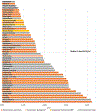Examination of Laws Allowing Sunscreen Use in Schools in the Context of UV Levels by State
- PMID: 32693982
- PMCID: PMC7855391
- DOI: 10.1016/j.jadohealth.2020.05.047
Examination of Laws Allowing Sunscreen Use in Schools in the Context of UV Levels by State
Abstract
Purpose: Sunscreen use provides ultraviolet radiation (UV) protection but is often limited in school settings because sunscreen is classified as an over-the-counter drug product. Some US states have laws allowing students to carry and self-apply sunscreen. We examined these laws in the context of state UV levels.
Methods: We obtained legislative information through April 2020 from the American Society for Dermatologic Surgery Association website and UV data for years 2005-2015 from Centers for Disease Control and Prevention's National Environmental Public Health Tracking website.
Results: Twenty-three states and District of Columbia have sunscreen laws, including 11 states with UV levels above the median UV level across states. There was no significant association between state UV levels and sunscreen laws.
Conclusions: The presence of state sunscreen legislation has increased but is not associated with UV levels. Future research could examine the implementation and public health effects of these laws.
Keywords: Prevention; Schools; Skin cancer; Sun-safety; Sunscreen; UV.
Copyright © 2020 Society for Adolescent Health and Medicine. All rights reserved.
Conflict of interest statement
Figures

Similar articles
-
Legislative review and recommendations for improving sun protection in schools.Pediatr Dermatol. 2024 Jul-Aug;41(4):654-659. doi: 10.1111/pde.15638. Epub 2024 May 7. Pediatr Dermatol. 2024. PMID: 38712690 Review.
-
Sun Safety Practices Among Schools in the United States.JAMA Dermatol. 2017 May 1;153(5):391-397. doi: 10.1001/jamadermatol.2016.6274. JAMA Dermatol. 2017. PMID: 28257534 Free PMC article.
-
Association of UV index and sunscreen use among White high school students in the United States.J Sch Health. 2013 Oct;83(10):750-6. doi: 10.1111/josh.12090. J Sch Health. 2013. PMID: 24020690
-
Optimal sunscreen use, during a sun holiday with a very high ultraviolet index, allows vitamin D synthesis without sunburn.Br J Dermatol. 2019 Nov;181(5):1052-1062. doi: 10.1111/bjd.17888. Epub 2019 May 24. Br J Dermatol. 2019. PMID: 31069787 Free PMC article. Clinical Trial.
-
National health strategies to reduce sun exposure in Australia and the United States.J Long Term Eff Med Implants. 2004;14(3):215-24. doi: 10.1615/jlongtermeffmedimplants.v14.i3.60. J Long Term Eff Med Implants. 2004. PMID: 15301665 Review.
Cited by
-
Non-linear association between air pollutants and secondary sensitive skin in acne patients.J Cosmet Dermatol. 2024 Dec;23(12):4007-4016. doi: 10.1111/jocd.16487. Epub 2024 Jul 26. J Cosmet Dermatol. 2024. PMID: 39057602 Free PMC article.
-
Assessing Sun Protection Policies in Texas School Districts Located in Counties With the Lowest and Highest Melanoma Risk: Content Analysis and Cross-Sectional Study.Cancer Control. 2025 Jan-Dec;32:10732748251352702. doi: 10.1177/10732748251352702. Epub 2025 Jun 23. Cancer Control. 2025. PMID: 40550782 Free PMC article.
References
-
- U.S. Department of Health and Human Services. The Surgeon General’s call to action to prevent skin cancer. Washington, DC: U.S. Dept of Health and Human Services, Office of the Surgeon General; 2014. - PubMed
-
- U.S. Food and Drug Administration. Sunscreen. How to help protect your skin from the sun Available at: https://www.fda.gov/drugs/understanding-over-counter-medicines/sunscreen.... Accessed July 29, 2019.
-
- SUNucate protecting the public from skin cancer. Available at: https://sunucate.org/about/. Accessed July 29, 2019.
-
- American Society for Dermatologic Surgery Association. SUNucate website. Available at: https://www.asds.net/asdsa-advocacy/advocacy-activities/sunucate. Accessed July 29, 2019.
Publication types
MeSH terms
Substances
Grants and funding
LinkOut - more resources
Full Text Sources
Other Literature Sources
Medical
Miscellaneous

